STAYING ON COURSE WHEN SWIMMING IN OPEN WATER
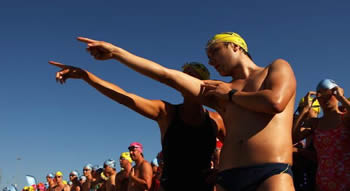
Swimming in open water is much different than swimming in a pool. Yes, you’re still swimming and it requires most of the same muscles but it is different. To be effective in open water swimming you need to get adept at staying on course.
A good friend of mine, Scott Calender, wore his Garmin at the Desert Triathlon a couple weeks ago and downloaded the route he swam afterwards. While he thought he was swimming on course he was amazed at how much distance he added by not swimming straight.
So here are a couple tips:
- Wear good goggles: Old, scratched up goggles impair your vision. Pony up the $10.00 for a new pair.
- Get some defogger: New goggles aren’t any good if they’re all fogged up. Yes, they make anti-fog goggles but use the defogger in case.
- Wear the appropriate goggles: I always take a pair of clear and a pair of smoke goggles and wear the ones that are appropriate for the light.
- Sight: Effective sighting is the best way of staying on course. Check out the course early if you can to find out what landmarks you can use to help you stay on track. At the Desert Triathlon there was a palm tree I used on the way out and the peak of a mountain on the way back.
- Sight frequency: Early in the race, and as you approach a turn buoy, you should be sighting more. I generally start out sighting every four strokes and stretch it out to six, eight, 10 then 12 as I go. Sighting slows you down and takes more energy so you want to minimize it as much as possible but not to the detriment of staying on course.
- Practice swimming without looking: Most people favor their left or their right. As a result, if you don’t watch where you’re going you’re going to veer off a straight line. You can practice swimming in a straight line by swimming in a pool, in your own lane, with your eyes closed. You’ll find out very quickly which way you favor. Try this in open water as well. When you know the direction you favor you can compensate for it during your races.
I hope these tips help YOU stay on course during your next race.
OVERTRAINING
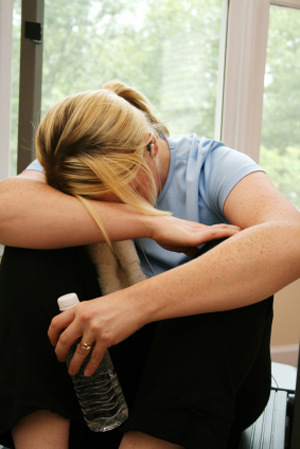 I never had to worry about overtraining because I was a chronic undertrainer. I have always enjoyed the triathlon lifestyle but I liked racing more than training. That’s probably where my son got it . . . he likes doing 5Ks but hates training!
I never had to worry about overtraining because I was a chronic undertrainer. I have always enjoyed the triathlon lifestyle but I liked racing more than training. That’s probably where my son got it . . . he likes doing 5Ks but hates training!
These days it’s sort of the opposite. I enjoy training more now but I’m on the edge of overtraining. So how do you know when your body has had enough? Here are some thoughts . . .
Heartrate
If you’re not checking your heartrate on a regular basis you should. One great indicator of overtraining and oncoming illness is an elevated heartrate.
Try to get into the habit of checking your heartrate either the first thing in the morning before you get out of bed or last thing at night just before you turn out the lights. Grab your sports watch and find your pulse (neck is easiest). Count the beats for 10 seconds and multiply by six. That’s your resting heartrate.
You’ll notice that your resting heartrate will be elevated when you’re overtraining or getting sick.
No Fun
If you usually enjoy your workouts but they simply aren’t fun anymore you could be overtraining. Some of you will say that it’s never fun, but you know what I mean.
If you’re training in large volumes but find it tougher and tougher to get “up” for your workouts you may be overtraining.
Sloth like Workouts
Some days your workouts may not have the “zip” that they usually do. If you find that you just can’t hit that 100-meter pace in the pool or the MPH pace you’re used to, you may be overtrained.
Sleep Problems
Most days I try to sneak in a short 15 – 20-minute nap. I’m successful at napping about four to five days a week. If you have the time and ability to nap go for it. However, if you “need” a nap because you’re not getting enough quality sleep at night you may have a problem.
When I’ve overtrained I may get to sleep easy enough but I can’t stay asleep. I’m tossing and turning for no good reason.
Muscle Soreness
So should you train when you have muscle soreness from a previous workout? In my opinion, it depends.
For example, if you’re early in your training season and don’t have any important races coming up, blow it off. On the other hand if you’re in your race phase with an approaching report I’m more likely to do the workout but either cut it short or do it with less intensity. This also helps prevent from over doing it.
When you’re shooting for a podium finish you’re going to be pushing yourself to new limits so be careful with your training. There’s a huge downside to overtraining including increased illness, injury and prolonged recovery.
When you think you’re overtraining you probably are. Back off, smell the roses and you’ll race better in the end.
Cheers!
MEASURING SUCCESS
 I had a potential client come in this past week to grill me about my coaching techniques. Naturally, every coach has a different style so I explained mine to him.
I had a potential client come in this past week to grill me about my coaching techniques. Naturally, every coach has a different style so I explained mine to him.
I’m hoping that one thing he realized is that he needs to measure his success with his own yardstick, not mine, or anyone else’s.
I try to make this point whenever I work with an athlete because I want their involvement in triathlon to be rewarding for them, no matter what their ideas of success are.
As you can tell, over the years my goals have changed. Initially it was about staying in shape. These days it’s all about punching my ticket to Kona. Those are my goals. I might state the obvious here that I’m not alone in the dream to reach that particular goal.
This gentleman has been working with another coach for several months and was hoping to better his time from last year at the Ironman California 70.3. He didn’t and was disappointed. Disappointed in his coach, and himself.
Believe me, I’ve had many disappointments in this sport as well. I’ve hoped to do well at races and fallen short of my goals. I may not have been fit enough or had a technical problem or even been over trained. Guess what? That’s life!
Before I work with an athlete I interview them and find out where they’ve been and where they’d like to go. I assess their performance and look at their race results. Only then do I give them what I think is a realistic idea of where they can go in the short-term. If you set the bar too high you’ll never reach it and always be disappointed. Set it too low and you’ll never know how great you can be.
How do you measure success? Completing your first triathlon? Completing your first Ironman? Winning the world championship? I work with athletes at all levels and help them achieve their goals.
So I say again “How do YOU measure success?”
TRI FRIENDS
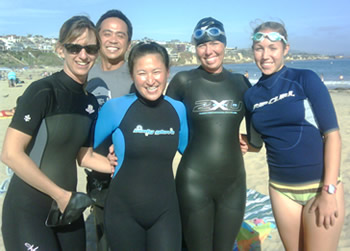 I have truly been blessed to have so many great friends in my lifetime. Some I’ve managed to keep since childhood and some are brand new. I’ve got all kinds of friends but none inspire me more than my triathlon friends.
I have truly been blessed to have so many great friends in my lifetime. Some I’ve managed to keep since childhood and some are brand new. I’ve got all kinds of friends but none inspire me more than my triathlon friends.
My first triathlon friend wasn’t even interested in the sport. Greg Fitts just knew I was pretty athletic so he inspired me to enter a local triathlon in Des Moines, Iowa. I borrowed a bike from another friend, Rich Freeman, and completed my first triathlon in 1983.
When I moved to California in 1984 I was inspired to keep the triathlon thing going by Les Sterrett. Les was a great triathlete and hooked me up with some other triathletes to complete a team to compete in the OC Triathlon (the original). After being part of a team for a couple years I ventured out on my own.
After that I was a regular at the local California triathlons but always mid-packer. I used my triathlons as a means to keep me motivated to workout. Absolutely nothing wrong with that. Any excuse you can have to stay fit.
In more recent years my tri buddies have included Mark Arenal and Vince Tjelmeland. Not only do I consider these guys my tri buddies but also my auto racing buddies. We ride, race and hang out a lot. Tonight we’re celebrating Vince’s recent nuptials.
It really wasn’t until 2006 that I started to get competitive in my age group. At that time I was in the M50-54 age group. I found I had more time, more money and more motivation to train . . . so I did.
I started having some good results and would occasionally find the podium but it wasn’t until I met a new group of friends that I started to see some really good results.
While a relative “newbie” to the sport, my good friend Larry (Lar Dog) Davidson has embraced the sport like no one else I know. He studies it and not only has all of the tech toys but knows how to use them too! He’s not only given me great advice but also kept me motivated to do better.
Another great friend is Russ Jones. Russ has been at this even longer than me. He’s extremely fit now and has dropped over 10 pounds and has his eye set on the world sprint championship. I have no doubt that if he’s on his game he’ll win. Russ always makes time to talk tri and also has tons of great advice.
Chris Johnson is my Ironman mentor. He has qualified, and competed in the Ironman World Championships 15 consecutive times. I enjoy his advice but I can only stand riding with him a couple times a year because he always kicks my butt!
One of my newer friends, Stuart Lowndes, is another relative newbie to the sport but has taken it by storm. We rode just this morning . . . or should I say I drafted off of him this morning. He’s gunning for another win at the Ironman 70.3 Texas. He’s trying to qualify for the world 70.3 championship in Clearwater. They can just hand him the spot right now as far as I’m concerned.
It’s been great having so many good friends in the sport. I certainly wouldn’t have enjoyed it as much, or done as well, without them. Perhaps you’ve found the same.
Cheers!
ANATOMY OF A 70.3 PR
 Okay, so how did I do it? How did I manage to put together the race of my life? Piece of cake!
Okay, so how did I do it? How did I manage to put together the race of my life? Piece of cake!
Training Volume
A key ingredient to race performance is how much you train, and how much you train in each segment. Most people don’t need to worry about training too much but some do. You know the A++ personality.
Primarily two things dictate your training volume: the distance you’re going to race and your age.
The longer the race, the more you’re going to have to train. The younger you are, the more you’re going to have to train. In my mind those are just the facts.
Now my good friend Russ Jones is about to embark on a career in triathlon training and his philosophy is “less is more.” I totally agree with this but race distance and age have a lot to do with it. So I guess if I could modify his philosophy a bit I’d say “Train as little as you have to, to win.” Not as catchy!
Concentrate On Your Weaknesses
I’m a strong believer in training harder on your weaknesses, but relative to your race distances. This generally isn’t appealing because you’re typically strongest at the thing you like to train at the best. For most triathletes that means they lack in their swimming and excel either in cycling or running.
But remember, I said relative to your race distances. In general, the swim comprises 20% of the overall time in sprint and Olympic distance races but only 10% in 70.3 and full Ironman races. So, if you’re not a swimmer, work on it, but not to the detriment of your cycling and running.
Concentrate on your weaknesses. For me that has always been my cycling. Here’s what I did this season: dropped one of my swim workouts (my strength) and picked up another cycling workout.
I now do three CompuTrainer workouts and one long ride each week. This really helps me because the bike portion of the race, no matter what the distance, is generally 50% of your overall time. That means I had a lot of room for improvement.
Training Consistency
Why does everyone think that it’s easier for the top athletes to crawl out of bed at 4:30 in the morning than for everyone else? It’s not! It’s a pain in the ass for all of us.
My typical week has me training seven days a week with a total of 11 distinct workouts (two-a-days on Monday – Thursday).
Don’t get lazy and blow your workouts off. Even if you can’t squeeze your full workout in, do something.
Strength Training
By far I think this is the thing that allowed me to still have legs after pushing so hard on the bike. Yes, I’ve been training really hard on the bike but the weight training has made a huge difference.
We harp on this all the time (especially Jarrett) but I believe it’s true. Naturally, if I have to miss a workout during the week it’s going to be strength session but I haven’t missed many.
Mental Toughness
I never got really competitive in my age group until a few years ago. My athletics were always about trying to stay in shape and hanging out with people that inspire me.
Within the last few years I’ve worked a lot harder at my racing, which has moved me up in the ranks. As a result, when I race I’m more confident.
It also helps that prior to the California 70.3 I had won my age group in the last three races. Granted, they were all small races but it does boost your confidence.
Age
I hate to admit this, but it does get better with age. There were 62 finishers in my age group (M55-59). There were 338 in the M40-44.
Hang around this sport long enough and you’ll eventually qualify for Kona.
Nutrition
Nutrition is critically important to the top triathlete. Oh hell, who am I kidding? I eat like crap. I hate to admit it but I went into this race seven pounds heavier than my ideal race weight and I eat junk food and ice cream on a regular basis.
Does that mean nutrition is overrated? Probably not, but I just don’t pay that much attention to it.
Now, since Ironman Arizona is my “A” race this year I will drop the weight and start eating better. While I’m not sure how much it matters I figure it’s got to be better for me and it’s cheap insurance.
Cheap Insurance
Speaking of cheap insurance, there are a lot of things you can do to help your race, especially your “A” races. Here are a few:
That’s all I can think of at this time. There’s no magic here just hard work, common sense and a little voodoo.
Cheers!
Ron
RACE REPORT: IRONMAN CALIFORNIA 70.3
Ron Saetermoe
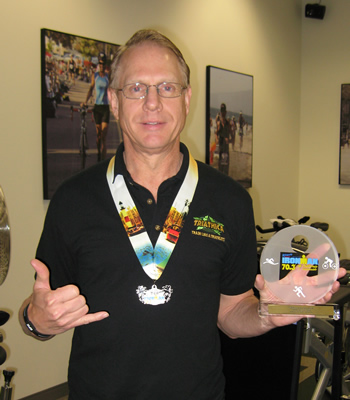 Ironman California 70.3 was a “B” race for me, which simply means it was important, but not my most important race of the season. It wasn’t my most important race because I had calculated that Ironman Arizona would be my best chance all year to punch my ticket to Kona.
Ironman California 70.3 was a “B” race for me, which simply means it was important, but not my most important race of the season. It wasn’t my most important race because I had calculated that Ironman Arizona would be my best chance all year to punch my ticket to Kona.
It was going to be a great day. The weather was perfect and the swim at Big Corona last Wednesday with Lar Dog wasn’t as cold as I had anticipated.
I was up at 3:00 a.m. and finished packing my gear and had my regular pre-race breakfast of cottage cheese with walnuts and blueberries, an English muffin with peanut butter and strawberry jam and a large glass of OJ. I was in my car on my way to the race by 4:00 a.m.
My wave wasn’t scheduled until 7:17 but I’m always early, by design. Got my stuff set up and chatted with a bunch of other athletes. I was loose and confident.
We all play these games in our head about things that can go right, and wrong. I figured if I had the perfect race I might be able to podium, but top-10 would have been fine with me. The reason is that the top two dogs in my new age group (M55-59) were both registered.
Dean Harper was the big dog. Back in the day, Dean was in the same pro ranks with guys like Dave Scott and Scott Tinley (who was there on a surf board at the swim start). The guy is still an amazing athlete. The other top guy was Kim McDonald. Kim is primarily known as a short-course guy and won the world sprint championships last year in Australia. He is simply amazing. So, since the first two slots were taken I figured, why not 3rd?
Never having met Dean before I asked around to see if anyone had seen him. I wanted to introduce myself and wish him a bad race (kidding). No one saw him but Kim traded emails with him and was sure he was coming.
Both Dean and Kim are known for their swimming prowess. And while I’m a “good” swimmer I’m certainly nowhere near their caliber. Last year they swam 26:04 and 27:17 respectively. I did 30:57. So I knew they’d both be well ahead of me on the swim.
The swim went well until about the final 300 yards where I nearly swam over the top of a large woman. She was so upset she kicked me. Look, I know it’s a bummer when someone swims over the top of you but no one is doing it on purpose. If you don’t want to be swum over get in the slow lane!
Anyway, I swam hard but since I had cut back on my swim workouts I was simply trying to hold the same time as last year. Not bad, went 31:06. The day was looking good so far.
Normally when I race against the “Dog” (Larry Davidson) we’re in the same age group but since I aged-up he went off in the wave in front of me four minutes earlier. Since I just swam with him on Wednesday I knew his swim had dramatically improved and that it was unlikely I was going to make up four minutes on him. True enough, Larry did 32:58. Great job!
I’m very speedy in transition and came in just seconds behind another formidable Ironman competitor, Brian Smallwood. Generally Brian beats me by a little bit on the swim then kicks my butt on the bike. Today I was off on my bike just ahead of him and I never saw him again all day. (Footnote: Brian beat me by 1 second at IMAZ when I stopped to see if he was okay when he fell just 10 feet from the finish line.)
It was a little cold getting on the bike but I knew I’d warm up because I planned to go hard. I had the karma of Russ Jones’ race wheels with me so I didn’t want to disappoint him. Russ is another great friend, supporter and athlete. He’s going for the sprint world championships this year. Odds are he’ll do it!
I pushed hard on the bike and whom do I see just ahead of me but Lar Dog. We trade a couple words as I pull ahead but he manages to catch me on the next hill. And that’s how the ride was all day. I’ll pull ahead on the downhills, we’d stay about even on the flats, and he’d pass me on the hills.
Now you have to understand that Larry is a far superior cyclist and runner than me and that the ONLY reason I was racing along side him was because he had just come back from St. George, Utah on a recon mission to check out the course there. He obviously wasn’t recovered from his training there but it sure made it nice for me to have someone I knew to help push me along.
I really couldn’t have pushed the bike any harder. I figured I’d lay it out there on the bike and just see if I could run at all. Guess what? It worked!
Guess what else, as I came in on the bike there was Kim McDonald just seconds ahead of me. I asked if he’d seen Dean and he said “no.” Kim was off. I had another speedy transition to the run. This year the only difference was that I was going to run with socks on. I got a massive blister last year so I figured I’d wear socks because I wasn’t going to be a contender anyway. I saw Kim pull away and figured that was it.
As usual, the first steps on the run my legs felt like lead. I’m not sure when it happened but Larry passed me on the run. Since he usually passes me on the run I figured that would be the last I would see of him all day. We chatted for a couple seconds and he pulled ahead. A funny thing happened though; even though he was ahead he wasn’t pulling away.
At about mile three I got a bad stitch in my side. You know the kind that only go away when you rest and catch your breath? It was to stay there for the remainder of the run.
I followed Larry for several miles, always keeping him in sight. Then, just ahead, I saw him stop at an aid station to take on some fluids and I caught up to him. We started to run together again and I told him I wasn’t sure I could hang on because my side was killing me. He said, “This is your day Ronnie.” so we both pressed on.
At one point Stu Lowndes a Triathica member and good friend yelled at me that I was only one minute behind Kim. Great information that I couldn’t do anything with! I was going as hard as I could and I also knew that Kim is an outstanding runner and I didn’t have a prayer of catching him even on my best day.
Eventually I pulled ahead of Larry and pushed as hard as I could. I watched my heart rate closely and kept it close to 170 (not advisable for most) but I knew I wasn’t running fast as I was suffering from cardiac drift.
I finished strong and totally exhausted. 4:55:25 a PR and a time I only dreamed of – 1:07 behind Kim – good enough for 2nd place! I missed qualifying for Kona by 1:08!
It was an unbelievable day for me. I’ve been competing for 48 years and Saturday was my proudest achievement.
Here are some additional times from some of my friends:
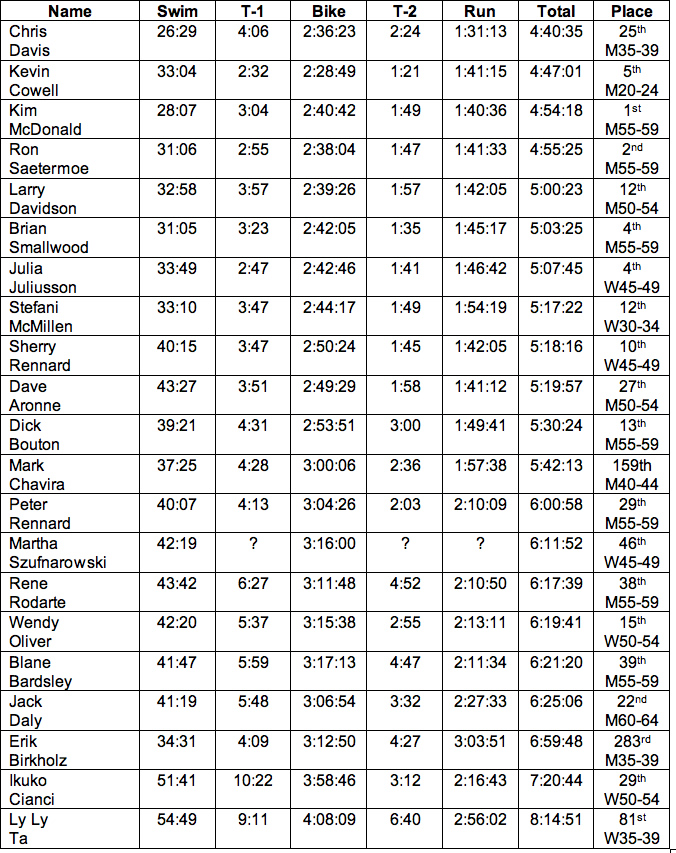
PRE-RACE PREPARATION
Ron Saetermoe
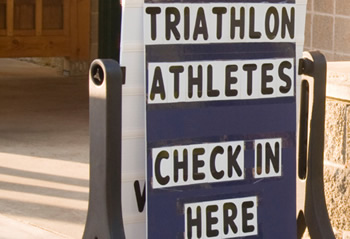 Anyone that knows me knows I’m a planner. I’m usually very well organized and nearly early for any event. I get it from my mom. She starts packing a month before her vacations!
Anyone that knows me knows I’m a planner. I’m usually very well organized and nearly early for any event. I get it from my mom. She starts packing a month before her vacations!
Even if you’re not much of a planner I suggest you start planning for your races early. Here are some tips:
Plan Your Year Early
It’s difficult to start planning your races too early. Check out the potential races you’re considering and ask the other athletes what they recommend. Determine how many races you want to do and space them out based on your schedule. For some that will mean just one race, and others will do 20 in one season (nutty, huh?).
Register Early
With so many races selling out these days it’s best to register as far in advance as you can. If you plan on doing any of the popular races such as Vineman 70.3 (already sold out), Malibu (will sell out) and the Pacific Coast Triathlon (will sell out) you need to register early.
Some races have early registration discounts, as do many clubs such as the Orange County Triathlon Club.
Get Your Gear In Order
Check out the list we have at www.triathica.com under Information/Resources/Triathlon Checklist or click here to download it. This is the most comprehensive list I’ve ever seen. Make sure you have all of the appropriate items and that they’re in good working order. I take my bike to Edge Cyclesports prior to every important race.
Check Out The Course
If possible, check out the course prior to the race. At times this isn’t practical but when it is, it’s a great confidence booster. The better you know the course the better you’ll race it.
Pack Early
Take my mom’s advice and start packing early. I start putting the stuff I don’t need on a regular basis aside about a week in advance. You know you’re going to be stressed so reduce that stress a bit by starting to get your stuff together early.
Lay out all of your gear and check it against your checklist. Check it out several times BEFORE packing it up.
Prepare Mentally
Start thinking about your race and visualize everything. Visualize the morning, the pre-race swim warm-up, the swim start and so on. This will help boost your confidence and help you deal with the unexpected . . . and there’s usually something unexpected.
For me, prior to the Desert Triathlon (I didn’t write about this in my race report) it was my clumsiness the evening before the race when I was practicing getting on and off my bike. I slipped and my leg got caught between the brake and the tire. Got a nice gouge in my leg. Thankfully, there were no more incidents.
Take it from me, the planner, the better you plan the better your race will go.
Cheers!
POSE RUNNING CLINIC AT TRIATHICA, MARCH 28TH
Pose is a running philosophy designed to help improve your running efficiency and reduce injuries. The local guru of Pose is Mike Collins of Multisports OC and his top protégé is Steven Owen.
Steven is going to be conducting an intermediate Pose clinic here at Triathica on Sunday, March 28th.
The clinic is open to all those that have some experience with Pose running. Included will be skills training to help you run up and down hills as well as strength training.
Conducting the strength training will be Kevin Rausch of Rausch Physical Therapy & Sports Performance. This promises to be a great clinic for anyone interested in improving their running efficiency and avoiding running injuries.
You can find more information about the clinic here:
https://www.clubassistant.com/club/clinics/reserve.cfm?c=83&cid=35820
ANDY BAILEY IS BACK
Ron Saetermoe
 Many of you know Andy Bailey’s story. Jarrett has written it about many times, including here in this newsletter.
Many of you know Andy Bailey’s story. Jarrett has written it about many times, including here in this newsletter.
Andy was injured on December 12, 2006 and eventually had his leg amputated on February 28, 2008 after an unsuccessful battle to try to save the leg. Since that time, he and his lovely wife Jeri have been working hard to get him back into the sport he loves: triathlon.
Well, none of us that know Andy had any doubt that he would be back, and he is. On Sunday, March 7th Andy did his first triathlon since his injury, and he did great!
This was the first year Klein-Clark, the race directors, gave out the Inspirational Award and naturally; Andy was one of two recipients.
So next time you see Andy congratulate him . . . he’s worked hard to get back and is truly an inspiration.
RACE REPORT: DESERT TRIATHLON
Ron Saetermoe
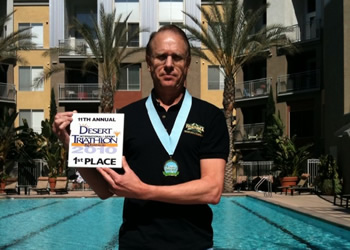 We knew the rain was coming but we were hoping that the mountains that surround Lake Cahuilla would push the clouds away. They didn’t. In fact, the rain started just as we made our way to the starting line.
We knew the rain was coming but we were hoping that the mountains that surround Lake Cahuilla would push the clouds away. They didn’t. In fact, the rain started just as we made our way to the starting line.
The Desert Triathlon on Sunday, March 7th would be my first International distance race of the season. I’ve been training for Ironman Arizona (and maybe Ironman St. George) so I’ve been doing longer distance runs and rides but I’m a big believer in racing to get ready to race.
The Desert Triathlon would be a “C” race for me — in other words, not very important for me. Naturally, you want to do well any time you race but you have to have your priorities. This race would just be a test of my fitness and a sharpener for my upcoming “B” race, the California Ironman 70.3.
The old dudes, 40+ would start last at 8:45 a.m. I hate starting last because that just means I have to pass more people on the swim (I’m a good swimmer – not bragging, just sayin’).
The water was quite cold. Don’t know exactly what the temp was but I’m guessing low 60s. I’m not a big fan of cold as evidenced by my IM Arizona performance last November (no puking this time).
The gun went off and I was having a tough time catching my breath so I slowed down a little. After a couple hundred yards I got into a comfortable groove and settled in. Problem is I was alone. The really fast guys were too far out in front and I didn’t want to go any slower so I was on my own.
I passed a number of the slower swimmers from the earlier waves and felt good after rounding the first buoy. The cold water didn’t seem to bother me and the second half of the swim was faster than the first.
When I exited the water I realized how cold I actually was because I couldn’t move my thumbs. The rain and wind picked up. This was going to be fun!
The bike portion of the race went fine. I felt like I was working hard but felt good. The rain picked up and the roads were drenched so I’m not sure how much slower that made me. The bike portion for the International distance is two loops for a total of 24 miles so we were on our bikes a while.
I only saw one guy in my age group pass me and I passed one guy in my age group on the bike but I had no idea how many were ahead of me.
Getting into T-2 I was obviously even colder than before because I couldn’t get my helmet unbuckled. Weird how much we depend on our thumbs! Then, I couldn’t get my shoes tightened so that took a while. No transition PRs today!
While I was quite cold the run felt great. I missed my buddy Larry, Lar-Dog Davidson because he’d beaten me every year here but by a lesser margin each time. Today I would have given him a run for his money (probably still would have lost though).
I got into a groove as my heart rate hovered around 160 (comfortable for me). I passed a ton of people including a 50 year-old guy. I saw Russ Jones after the first lap (he had just won his age group in the sprint race) and he told me he thought I was in first place. That just made me go faster.
While unbelievably cold, it was a great day. I took first place in my age group and managed to turn in the EXACT same time as last year. My swim was slower, my T-1 was slower, my bike was slower, my T-2 was slower but my run was significantly faster.
What a great way to start the season!
Here are some of my friend’s results:
Sprint Distance
Carlos Espinoza 1:06:21 (1st place M35-39)
Russ Jones 1:06:30 (1st place M55-59)
Rich Pfeiffer 1:09:59 (2nd place M55-59)
K.C. Heidler 1:13:11 (4th place M40-44)
Steven Owen 1:14:46 (3rd place M55-59)
Andy Bailey 2:15:44 (5th place M70-74)
International Distance
Chris Davis 2:01:45 (3rd place M35-39)
Scott Calendar 2:02:36 (1st place M45-49)
Ron Saetermoe 2:08:07 (1st place M50-54)
Sam Sunshine 2:13:06 (10th place M45-49)
Sherry Rennard 2:18:10 (3rd place F45-49)
Jeremy Rock 2:21:25 (18th place M45-49)
Mark Chavira 2:24:02 (24th place M40-44)
Pete Rennard 2:24:57 (3rd place M55-59)
Kevin Cowell 2:58:30 (3rd place M15-19 – walked the run course)
Janet Richard 3:08:59 (22nd place F40-44)


